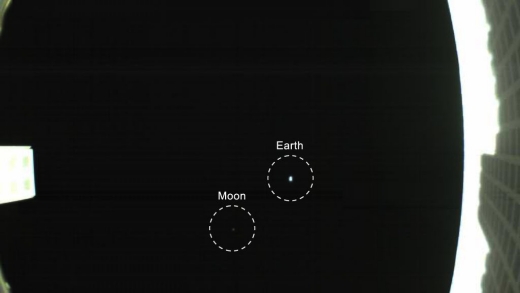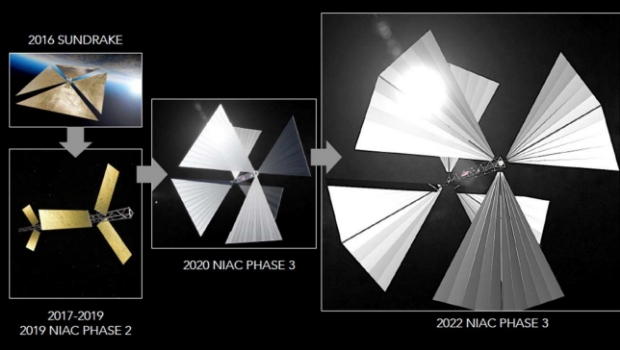We need to get to the ice giants. We have limited enough experience with our system’s larger gas giants, although orbital operations at both Jupiter and Saturn have been highly successful. But about the ice giants, their formation, their interiors, their moons (and even the possibility of internal oceans on these objects), we draw on only a single mission, Voyager II. Which is why the April 2022 decadal study (“Origins, Worlds, and Life: A Decadal Strategy for Planetary Science and Astrobiology 2023-2032”) recommended a Uranus mission, complete with orbiter, to be launched in the late 2030s.
Can we do this under our existing paradigm for space exploration? A new paper titled “Science opportunities with solar sailing smallsats,” written by the Jet Propulsion Laboratory’s Slava Turyshev and co-authored by major proponents of solar sail technologies, makes the case for coupling our abundant advances in miniaturization with our growing experience in solar sails to achieve missions at significantly lower cost and substantial savings in time. Because staying within the traditional game plan, we are constrained by slow chemical propulsion (or low-readiness nuclear methods) as well as decades of mission planning, not to mention cruise times in the range of 15 years to reach Uranus. These are numbers that can and should be improved, and greatly so.
Fortunately, solar sailing is moving beyond the range of experiment toward practical missions that will build on each other to advance a new paradigm – smaller and faster. Much smaller and much faster. Consider: The Japanese IKAROS sail has already demonstrated the interplanetary possibilities of sails, while the success of The Planetary Society’s LightSail-2 helped to energize the NEA-Scout mission NASA launched in 2022. Concept studies continue. Japan developed OKEANOS, a hybrid sail/ion engine design as an outer planet mission as a follow-on to IKAROS (the mission was a finalist for funding but lost out to a space telescope called LiteBIRD).
But sail technology must be wed with practical payloads, and spacecraft acceleration is proportional to the sail area divided by the spacecraft mass, which means that miniaturization and the use of smallsats win on efficiency. Here we’re reminded of the recent success of the Mars Cube One (MarCO) smallsats, which worked in conjunction with the InSight Lander and demonstrated the practicality of the highly modular and integrated CubeSat format for missions well beyond Earth orbit (see MarCO: Taking CubeSat Technologies Interplanetary). Let’s remember too the advantage of smallsat launches as ‘rideshare’ payloads, significantly reducing the outlay needed.

Image: The first image captured by one of NASA’s Mars Cube One (MarCO) CubeSats. The image, which shows both the CubeSat’s unfolded high-gain antenna at right and the Earth and its moon in the center, was acquired by MarCO-B on May 9, 2018. Credit: NASA/JPL-Caltech.
Solar sails are fast and, using the momentum of solar photons, require no onboard propellant, as both chemical and electrical methods do. Wedding sail propulsion to miniaturization in smallsats opens the way for spacecraft sent on ‘sundiver’ trajectories to harvest momentum from solar photons for the push to the outer Solar System. Here we’re taking advantage of a sail’s ability to change orbit by adjusting its attitude, another obvious plus. The authors believe that sailcraft built along these lines can achieve speeds of 33 kilometers per second, which works out to roughly 7 AU per year.
All of this leads to particular types of mission. From the paper:
As the solar sailing smallsats will be placed on very fast trajectories, placing Sundivers in orbit around a solar system body will be challenging. However they naturally yield several mission types including fast flybys, impactors, formation flights, and swarms. As the weight of the system is constrained, any instruments on board need to be small, lightweight, and low-power. Given the ongoing efforts in miniaturization of many instruments and subsystems, these challenges will be met by our industry partners who are already engaged in related technology developments.
As we continue to refine sail materials and advance deployment strategies, we are also learning how to harden smallsat computers for deep space while modularizing their components. Jupiter will be reachable with cruise times of two years, Saturn with three. What looms now is further development in the form of a technology demonstration mission (TDM) that has grown out of Turyshev and team’s Phase III study for NASA’s Innovative Advanced Concepts Office based on a sailcraft design that may one day reach the Sun’s gravity lens, which for effective science begins at 550 AU and extends outward.
The TDM would further develop solar sail technologies with an eye toward the kind of ‘sundiver’ maneuver that would make such fast missions possible. It will be enabled by a series of preparatory solar sail flights that will validate the final TDM vehicle.
Coming back briefly to an ice giant mission, designing and building the kind of craft envisioned in the 2022 Decadal is at least a decade’s work, and the cost of sending an orbiter to Uranus likely pushes beyond $4 billion. We’re contemplating this at the same time that the Decadal Survey is recommending, as its second highest priority for the upcoming decade, an Enceladus orbiter/lander flagship mission. NASA’s budget would be strained to the maximum to get even the Uranus mission off in the 2030s, which would push our next encounter with the ice giants back yet another decade.
The authors argue that we need to get realistic about what we can do with fast flybys not just to the ice giants but to numerous destinations in the Solar System. In the next several posts, I want to explore the TDM mission as presented in the new paper, considering the mission concept and implications before moving on to look at the kind of destinations the combination of sails and smallsats will enable us to reach.

Image: This is from the paper’s Figure 1, showing sailcraft design evolution during the period of 2016-2022. We’ll talk about this unusual configuration in the next post.
The paper is Turyshev et al., “Science opportunities with solar sailing smallsats,” available as a preprint.



First off, I would love to see this 1/3rd-sized L. Garde solar sail design tested. But even more importantly, I would like to see evidence that mass manufacturing can be done to reduce the unit cost. Build a dozen and using rideshare run different missions to test them out.
The paper has all sorts of fast flyby mission ideas, but there seems to be a lot of handwaving about the payload and instrumentation. The term small satellites is widely used, but I think they are talking more about CubeSats which are currently an design architecture which overlaps in mass when used in combination. Some of the proposed missions assume small payloads (unit Cubesats?) that rendezvous and dock to make a larger payload. AFAIK, this is totally new and so far not even designed. There is also a rather unexplainable idea that docking units will slow down a completed probe. I don’t understand how that happens. There also seems to be an assumption of power sources and electric propulsion but with no supporting information.
While cheap, CubeSats still have a high failure rate. Whether they are capable of missions to Jupiter, the outer planets, and beyond is unknown. There will need to be some serious engineering work to make them robust enough as well as keep costs down. Many of the fast missions require a sundiver maneuver which puts extra thermal management on the payloads.
Having said this, I definitely think this is a good direction to go. Mass manufacture designs of both the solar sail propulsion and the payloads so that multiple probes can be sent out like dandelion seeds across the solar system. Many will fail, but a fraction will not and return data. Staggering the flights will allow multiple flybys to collect data on each target.
If the Venus Life Finder mission flies and returns data, this will show that a small instrument payload can be designed and work successfully. Innovative, miniaturized instrument designs will be like consumer medical products compared to large, hospital units, or early PCs compared to mainframes. Once considered “toys”, tiny computers evolved smartphone configurations that have proved relatively inexpensive and very sophisticated.
I hope I live long enough to see the early flights of some of the proposed missions.
While nowhere near as sophisticated, I am reminded that J P Aerospace has a “PongSat” program where any payload that can fit into a PingPong ball can be flown on their high-altitude balloons. I have no idea what the payloads are or their success rate, but to me, this is the sort of target size of instruments we should be eventually thinking about. Some instruments can never be that small because of physics but others can, and these latter should be the payloads, aggregated together, to be the probes to ride the solar sails.
I would love to see a list of potential instrumentation with minimum theoretical mass and size limits to show the range of information that could be collected.
Thanks for this, Alex. ‘PongSat’ is a new one on me. Interesting!
check out https://www.jpaerospace.com/
Some years ago they published Floating to Space. It was an outline of their plan to use LTA craft to slowly accelerate to orbital velocity. Even though I am skeptical, they have marched on with their plan and are getting close to testing a “small-scale” version. Their idea for a space station that floats at around 140,000 feet is very interesting.
If it was possible to identify rocks with this sort of trajectory and with the right profile from say 100-200 years out – could you go about establishing a base on the approaching rock? Say large enough for 3000-5000 people? Put enough infrastructure in place to allow long term steering and the ability to be self sufficient for 1000s of years? Would make for an interesting project and journey…
sorry – meant for the comment to be on the article below this one…
I just can’t get that excited about solar sails. They’re hard to steer and they’re still “slow”. Sure go for it, why not? I’m for it.
But what’s needed is FTL travel if we are to ever truly “break out” of our tiny spot in the cosmos. Well, that’s just impossible right? I sort of think so, especially given that none of our “friends” out there someplace don’t appear to have figured it out either (else they would be here explaining it). But perhaps there is just not anyone remotely nearby.
Or no one else whose time scale lines up with us.
Perhaps some of the long time problems in physics regarding FTL might be worth thinking about. Just for funsies, I suggest this video from a very popular German physicist. I get a kick out of her, though I am not a physicist myself and I have watched this thing 3 times now trying to grasp it. It only appeared a week or 2 ago.
https://www.youtube.com/watch?v=9-jIplX6Wjw